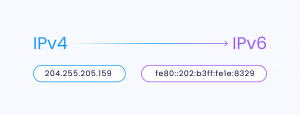
The IPv6 Paradox: Why the Internet's Future Protocol Remains in Transition
IPv6 adoption stalls at 40% despite IPv4 exhaustion. Learn why the transition won't complete until 2045 and what can be done instead.
This offer comes at a critical time. Nearly three decades after its introduction in 1995, IPv6 address adoption continues to progress at a surprisingly gradual pace. Despite IPv4 addresses becoming increasingly scarce, only about 40% of internet users worldwide can access IPv6-only services in 2024, according to APNIC Labs data.
This paradoxical situation raises important questions about the future of internet addressing and how organizations like IPXO are poised to bridge the transition gap.
THE PRESSING NEED VS. SLOW ADOPTION
IPv6 was designed to solve a critical problem: the limited capacity of IPv4's 32-bit addressing scheme, which supports only about 4.3 billion addresses. In contrast, IPv6's 128-bit addressing provides an astronomical 340 undecillion addresses (3.4×10³⁸) – theoretically enough to assign an IP address to every atom on Earth's surface and still have plenty left over.
The current allocation of IPv6 addresses across Regional Internet Registries (RIRs) shows significant variations in utilization. RIPE NCC leads with 23.65% of its available IPv6 addresses allocated, while AFRINIC has allocated just 1.05%. This uneven distribution reflects the complex regional dynamics of IPv6 adoption.
WHY HAS IPV6 ADOPTION BEEN SO SLOW?
Several factors have contributed to IPv6's gradual adoption. Network Address Translation has effectively extended IPv4's lifespan by allowing multiple devices to share a single public IP address.
As Jake Brander from Brander Group noted in IPXO's recent ecosystem webinar "Even at $50 an IP, it was still worth it to purchase the IP addresses because it's a streamlined process. You don't have to buy new gear, there's no learning curve, and there's no backwards compatibility issues."
In IPXO's separate webinar, Matthew Wilder, senior engineer at Telus, explained that IPv6 faces resistance because "there is an initial hurdle to get your staff aware and understanding IPv6." He added that while organizations must maintain IPv4 in some capacity, "the operation model of dual stack is going to be the way to transition."
The economic challenges of IPv6 adoption were also highlighted in this IPv6-focused webinar when Nathalie Kunneke-Trenaman from AMS-IX observed, "For network people, whenever you have an interest in technology, you're making money out of technology, that means by default that you have to keep up with technology otherwise you're out of a job at some point." Yet, as she pragmatically concluded, "The reality is we're stuck with IPv4 for a long time.”
WHEN WILL THE TRANSITION COMPLETE?
Recent projections from APNIC Labs suggest that at current adoption rates, IPv6 may not reach universal adoption until approximately 2045 – another two decades into the future. This timeline is particularly striking given that IPv4 exhaustion began over a decade ago.
Marco Hogewoning from RIPE NCC reflected on this prolonged transition during IPXO's webinar: "At every time, looking back 100 years ago, there are books when people think how would be the future within 20-30 years. What you see in those books, they looked at what technology existed at this moment and just made this a little bit more fancy."
He concluded that "it is likely that there's something completely new that right now we cannot even envision in 20-30-40 years, but it's also possible that in 20-30 years there's still IPv4."
IPXO'S ROLE IN A DUAL-STACK WORLD
The reality is that we're likely to remain in a dual-stack environment for the foreseeable future. This presents both challenges and opportunities for organizations managing IP resources. Experts noted that IPv6 adoption is growing at only "approximately 3-4% a year."
Meanwhile, Jake Brander emphasized that even with rising IPv4 prices, "the good news is that the market is evolving, so we definitely understand the problems." He also predicted that IPv4 prices would increase, noting that "the number of IPs available and the number of IPs that can be available will not sustain."
IPXO's comprehensive IP address management platform is uniquely positioned to assist organizations navigating this transition period. By providing flexible IPv4 leasing solutions, IPXO enables organizations to maintain essential IPv4 connectivity while developing IPv6 implementation strategies at their own pace.
The volatility of IPv4 pricing, which saw significant fluctuations over 2023-2024, creates financial uncertainty for organizations purchasing addresses outright. Leasing through IPXO transforms unpredictable capital expenditures into stable operational costs, providing financial predictability during the extended transition.
With its extensive experience in IP resource management, IPXO offers invaluable insights into efficient dual-stack implementation and eventual IPv6 migration. The platform works with clients to develop realistic timelines for IPv6 adoption while ensuring IPv4 resources remain available throughout the transition process.
LOOKING FORWARD
The journey to IPv6 will continue to evolve, likely with unexpected developments along the way. As the internet architecture continues its transformation from an address-centric model to one increasingly dominated by names and services, the role of flexible IP resource management becomes even more crucial.
Organizations that approach this transition strategically, leveraging solutions like IPXO's IP address platform, will be best positioned to maintain operational stability while preparing for whatever the future internet infrastructure might bring. For the foreseeable future, the internet will continue operating in this dual-protocol environment, making platforms that efficiently manage and monetize IP resources essential components of a sustainable internet ecosystem.
Jolita Puzakova
IPXO
email us here
Visit us on social media:
LinkedIn
YouTube
X
Distribution channels: Business & Economy, IT Industry, International Organizations, Technology, Telecommunications
Legal Disclaimer:
EIN Presswire provides this news content "as is" without warranty of any kind. We do not accept any responsibility or liability for the accuracy, content, images, videos, licenses, completeness, legality, or reliability of the information contained in this article. If you have any complaints or copyright issues related to this article, kindly contact the author above.
Submit your press release


